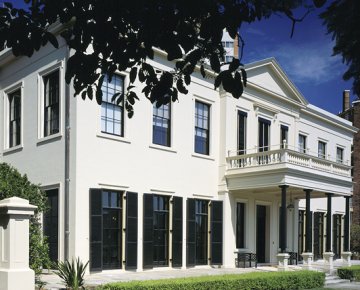Elizabeth Bay House
Posted on July 20, 2011 - Filed Under Historic Sites
Tags: Elizabeth Bay, Elizabeth Bay House, Sydney Historic Sites, things to do in Sydney
Elizabeth Bay House overlooks Sydney Harbour and was once considered ‘the finest house in the colony.’ It was built between 1835 and 1839 and is a spectacular example of colonial architecture. It was once part of a 54 acre estate but now only a small portion of the gardens remain. The elegant interior is furnished to reflect the time in which the home was built and offers a window into the lifestyle of the original occupants, the Macleay family.

The Macleay Family:
Alexander Macleay was born in Scotland in 1767. He arrived in Sydney with his wife and six daughters in 1826. He loved Sydney and soon persuaded many other family members to join him in the new colony.
Macleay accepted the post of Colonial Secretary of New South Wales in 1825, but only out of financial necessity. He was a well-educated man with many interests including entomology, horticulture, landscape design, architecture, natural history illustration and fine art. Unfortunately, these interests caused him financial difficulties. He lost his job at the Transport Board in England in 1818 and had lost money due to the failure of his brother’s bank. Despite this, he continued to spend liberally on his hobbies. This led him to take a series of loans and as a result, he needed a new job.
On arrival in Sydney, Macleay and his family lived in the Colonial Secretary’s House adjacent to Government House. Macleay was the senior civil servant of the colony and enjoyed a good relationship with Governor Darling. Governor Darling granted Macleay 54 acres of land at Elizabeth Bay.
Macleay initially used the land to create a landscaped garden. Much of the original bush was retained but was populated with other exotic plants such as ferns and orchids. Structures were added including cottages, terrace walls and turreted stables.
Due to the expense of the gardens, plans to build the house were delayed until 1835. Unfortunately, further financial strains from Macleay’s forced resignation over disagreements with the new governor resulted in more delays. As a result, the house was not habitable until 1839.
The Design of Elizabeth Bay House and John Verge:
The design and construction of Elizabeth Bay House reflected the emergence of a colonial middle class and the movement towards building detached villa-style homes within several acres of landscaped gardens. The design of the house is largely associated with similar Greek Revival style villas built on nearby Woolloomooloo Hill for civil servant heads of departments. Many of these villas were designed and built by architect John Verge, although the extent of Verge’s involved with the Elizabeth Bay House building project is unclear. John Bibb, Verge’s employee and successor is likely to have been responsible for designing the original plans while Scottish builder-architect, James Hume supervised much of the building.
The rooms within Elizabeth Bay House are all arranged around a central hall. The hall is an oval-shaped saloon with a winding staircase and domed roof. It is the home’s key architectural feature and is naturally lit by glass panels in the domed roof. The principle rooms including a library, dining room and drawing room are located on the ground floor. They are all linked to the saloon and to each other. The service rooms are located on either side of the back stairs, offering the staff discreet access to all areas of the house.
The upper floor is home to a morning room (a small daytime sitting room used by the Macleay women) and six bedrooms. The four main bedrooms have adjacent dressing rooms while the two servants bedrooms do not. Part of the upper floor is used for changing exhibitions that focus primarily on the social history of New South Wales.
The house also features two separate cellars – one for the storage of wine and the other for the storage of dairy and coal.
The Entomology Collection:
Alexander Macleay was a keen entomologist. In England he had served as the secretary of the Linnean Society, a gentleman’s scientific society. During that time he amassed what was thought to be the largest private collection of insects. He retained his enthusiasm for entomology and other sciences throughout his life in Sydney.
At the time it was built, the library at Elizabeth Bay House was the largest room in an Australian house, reflecting the importance of scientific endeavours in the lives of the Macleay family. Alexander continued collecting insects throughout his life. His collection mainly featured butterflies and moths. His son later added to the collection and broadened it to include other biological specimens, including marine life.
Eventually the collection was given to the University of Sydney but some remains on display in the drawing room and the library at Elizabeth Bay House.
After the Macleay Family:
Elizabeth Bay House remained in the Macleay family until 1911. Over that time, the grounds were subdivided several times to ease the family’s financial strains. In 1911 the house was sold to tenant George Michaelis. Michaelis was a leather merchant and a prominent member of Sydney’s Jewish community.
The home housed many different occupants and underwent many changes throughout the following years. However, in 1959 it was declared a historic building and in 1963 it was acquired by the Cumberland County Council and State Planning Authority. Tenants still occupied the building until 1974. It was only then that repairs and restoration work could begin. The house was to be used as apartments for the Lord Mayor of Sydney and guests of the City Council, but in 1973, Premier Neville Wran fought a public use for the house. In 1975 the house was placed under the Elizabeth Bay House Trust and in 1977, it was opened to the public as a museum.
The house is now managed by the Historic House Trust and has been restored and refurbished to represent how it might have looked between 1839 and 1845 when the Macleay family lived there.
Important Information:
Admission:
General admission is $8.00 Au for adults, $4.00 Au for children or $17 for a family.
Admission is free with a See Sydney Card.
Guided tours are available on request.
Location:
Elizabeth Bay House is located 4km east of the Sydney CBD at 7 Onslow Avenue, Elizabeth Bay. It can be accessed by public transport or by car.
Bus – Bus 311 leaves from Gresham Street in the city and stops on Greenknowe Avenue, approximately a 10 minute walk from the entrance to Elizabeth Bay House. Alight from the bus at the first stop on Greenknowe Avenue and walk down Onslow Avenue. Elizabeth Bay House will be on your left. The Sydney Explorer Bus also stops in Macleay Street, Kings Cross, approximately a 5 minute walk from the house.
Train – Kings Cross Station is approximately a 10 minute train trip along the Eastern Suburbs/Illawarra railway line from Central Station. From there, it is a 5-10 minute walk to the house.
Car – Car parking in the surrounding streets is limited and is time restricted for non-residents. If you are driving, you may prefer to leave your car in a parking station at Kings Cross and walk.
Nearby Attractions:
Nearby attractions include Vaucluse House, Rushcutters Bay and Kings Cross.
Opening Hours:
Elizabeth Bay House is open 9:30am-4:00pm Friday to Sunday. It is closed on Christmas Day and Good Friday.
Food Services:
A small café is located on site.
Shop:
A small gift shop is located on site.
Access:
The ground floor, including the major reception rooms is wheelchair accessible. There is a designated wheelchair accessible car park adjacent to the south east driveway.
Contact Details:
You can contact the Elizabeth Bay House directly on (02) 9356 3022.
Have You Visited Elizabeth Bay House?
Please share your experiences of or questions about the Elizabeth Bay House in the comments box below.
This entry was posted on Wednesday, July 20th, 2011 at 10:32 am and is filed under Historic Sites. You can follow any responses to this entry through the RSS 2.0 feed. You can leave a response, or trackback from your own site.
Comments
3 Responses to “Elizabeth Bay House”
Leave a Reply








皇冠线上投注网…
[…]Elizabeth Bay House – Sydney Australia[…]…
Hello mates, pleasant article and nice arguments commented here, I am really enjoying by these.
Asking questions are genuinely fastidious thing if you are not understanding anything entirely,
except this paragraph gives fastidious understanding yet.